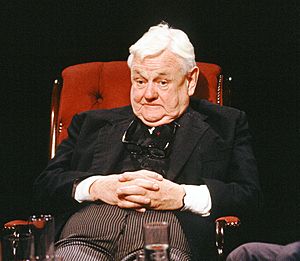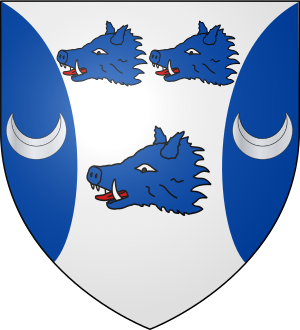Quintin Hogg, Baron Hailsham of St Marylebone facts for kids
Quick facts for kids
The Lord Hailsham of St Marylebone
|
|||||||||||||||||||||||||||||||||
|---|---|---|---|---|---|---|---|---|---|---|---|---|---|---|---|---|---|---|---|---|---|---|---|---|---|---|---|---|---|---|---|---|---|

Hogg in 1990
|
|||||||||||||||||||||||||||||||||
| Lord Chancellor | |||||||||||||||||||||||||||||||||
| In office 4 May 1979 – 13 June 1987 |
|||||||||||||||||||||||||||||||||
| Prime Minister | Margaret Thatcher | ||||||||||||||||||||||||||||||||
| Preceded by | The Lord Elwyn-Jones | ||||||||||||||||||||||||||||||||
| Succeeded by | The Lord Havers | ||||||||||||||||||||||||||||||||
| In office 20 June 1970 – 4 March 1974 |
|||||||||||||||||||||||||||||||||
| Prime Minister | Edward Heath | ||||||||||||||||||||||||||||||||
| Preceded by | The Lord Gardiner | ||||||||||||||||||||||||||||||||
| Succeeded by | The Lord Elwyn-Jones | ||||||||||||||||||||||||||||||||
| Shadow Home Secretary | |||||||||||||||||||||||||||||||||
| In office 13 April 1966 – 20 June 1970 |
|||||||||||||||||||||||||||||||||
| Leader | Edward Heath | ||||||||||||||||||||||||||||||||
| Preceded by | Peter Thorneycroft | ||||||||||||||||||||||||||||||||
| Succeeded by | James Callaghan | ||||||||||||||||||||||||||||||||
| Secretary of State for Education and Science | |||||||||||||||||||||||||||||||||
| In office 1 April 1964 – 16 October 1964 |
|||||||||||||||||||||||||||||||||
| Prime Minister | Sir Alec Douglas-Home | ||||||||||||||||||||||||||||||||
| Preceded by | Edward Boyle (Minister for Education) | ||||||||||||||||||||||||||||||||
| Succeeded by | Michael Stewart | ||||||||||||||||||||||||||||||||
| In office 14 January 1957 – 17 September 1957 Minister for Education |
|||||||||||||||||||||||||||||||||
| Prime Minister | Harold Macmillan | ||||||||||||||||||||||||||||||||
| Preceded by | Sir David Eccles | ||||||||||||||||||||||||||||||||
| Succeeded by | Geoffrey Lloyd | ||||||||||||||||||||||||||||||||
| Lord President of the Council | |||||||||||||||||||||||||||||||||
| In office 27 July 1960 – 16 October 1964 |
|||||||||||||||||||||||||||||||||
| Prime Minister | Harold Macmillan Sir Alec Douglas-Home |
||||||||||||||||||||||||||||||||
| Preceded by | The Earl of Home | ||||||||||||||||||||||||||||||||
| Succeeded by | Herbert Bowden | ||||||||||||||||||||||||||||||||
| In office 17 September 1957 – 14 October 1959 |
|||||||||||||||||||||||||||||||||
| Prime Minister | Harold Macmillan | ||||||||||||||||||||||||||||||||
| Preceded by | The Earl of Home | ||||||||||||||||||||||||||||||||
| Succeeded by | The Earl of Home | ||||||||||||||||||||||||||||||||
| Leader of the House of Lords | |||||||||||||||||||||||||||||||||
| In office 27 July 1960 – 20 October 1963 |
|||||||||||||||||||||||||||||||||
| Prime Minister | Harold Macmillan | ||||||||||||||||||||||||||||||||
| Preceded by | The Earl of Home | ||||||||||||||||||||||||||||||||
| Succeeded by | The Lord Carrington | ||||||||||||||||||||||||||||||||
| Chairman of the Conservative Party | |||||||||||||||||||||||||||||||||
| In office 18 September 1957 – 14 October 1959 |
|||||||||||||||||||||||||||||||||
| Leader | Harold Macmillan | ||||||||||||||||||||||||||||||||
| Preceded by | The Lord Poole | ||||||||||||||||||||||||||||||||
| Succeeded by | Rab Butler | ||||||||||||||||||||||||||||||||
| Lord Keeper of the Privy Seal | |||||||||||||||||||||||||||||||||
| In office 14 October 1959 – 27 July 1960 |
|||||||||||||||||||||||||||||||||
| Prime Minister | Harold Macmillan | ||||||||||||||||||||||||||||||||
| Preceded by | Rab Butler | ||||||||||||||||||||||||||||||||
| Succeeded by | Edward Heath | ||||||||||||||||||||||||||||||||
| First Lord of the Admiralty | |||||||||||||||||||||||||||||||||
| In office 19 October 1956 – 14 January 1957 |
|||||||||||||||||||||||||||||||||
| Prime Minister | Anthony Eden | ||||||||||||||||||||||||||||||||
| Preceded by | The Viscount Cilcennin | ||||||||||||||||||||||||||||||||
| Succeeded by | The Earl of Selkirk | ||||||||||||||||||||||||||||||||
| Parliamentary Under-Secretary of State for Air | |||||||||||||||||||||||||||||||||
| In office 12 April 1945 – 4 August 1945 Serving with The Lord Sherwood and The Earl Beatty
|
|||||||||||||||||||||||||||||||||
| Prime Minister | Winston Churchill | ||||||||||||||||||||||||||||||||
| Preceded by | The Lord Sherwood | ||||||||||||||||||||||||||||||||
| Succeeded by | John Strachey | ||||||||||||||||||||||||||||||||
|
|||||||||||||||||||||||||||||||||
| Personal details | |||||||||||||||||||||||||||||||||
| Born | 9 October 1907 London, England |
||||||||||||||||||||||||||||||||
| Died | 12 October 2001 (aged 94) London, England |
||||||||||||||||||||||||||||||||
| Political party | Conservative | ||||||||||||||||||||||||||||||||
| Spouses |
Natalie Sullivan
(m. 1932; div. 1943)Mary Martin
(m. 1944; died 1978)Deirdre Shannon
(m. 1986; died 1998) |
||||||||||||||||||||||||||||||||
| Children | 5 | ||||||||||||||||||||||||||||||||
| Education | Christ Church, Oxford | ||||||||||||||||||||||||||||||||
Quintin McGarel Hogg, Baron Hailsham of St Marylebone (born October 9, 1907 – died October 12, 2001) was an important British politician. He was a member of the Conservative Party. He served as Lord Chancellor, a very senior legal and political role, twice: from 1970 to 1974 and again from 1979 to 1987.
For a time, he was known as the 2nd Viscount Hailsham. He gave up this inherited title in 1963 to continue his political career in the House of Commons. Later, in 1970, he was given a new title for life, becoming a "life peer," which allowed him to return to the House of Lords.
Contents
Early Life and Education
Quintin Hogg was born in London. His father, Douglas Hogg, 1st Viscount Hailsham, was also a Lord Chancellor. His grandfather, Quintin Hogg, was a businessman and worked to improve education.
Quintin went to Sunningdale School and then Eton College, which are famous schools. He then studied at Christ Church, Oxford University. He was very good at his studies, earning top grades. In 1931, he became a Fellow at All Souls College, Oxford, studying law. He became a lawyer in 1932.
In 1933, he spoke in a famous debate at the Oxford Union, a student debating society. The debate was about whether people would fight for their country.
Political Career and World War II
Quintin Hogg was involved in politics from a young age. He took part in every general election campaign from 1924 until his death.
In 1938, he was chosen to run for Parliament in a special election in Oxford. He won this election, becoming a Member of Parliament (MP).
Hogg supported Winston Churchill during World War II. He served as a soldier in the Rifle Brigade and was injured in 1941. After his injury, he worked on the staff of a general before leaving the army as a major.
Serving as a Conservative Minister
In 1950, Quintin Hogg's father passed away. Hogg then inherited his father's title, becoming the second Viscount Hailsham, and moved to the House of Lords. He thought his political career in the House of Commons was over. He focused on his work as a lawyer.
However, in 1956, he became the First Lord of the Admiralty, which was in charge of the Royal Navy. He was involved in discussions about using military force in Egypt, which he thought was a bad idea.
In 1957, he became the Minister of Education for a short time. Later that year, he became Lord President of the Council and Chairman of the Conservative Party. Under his leadership as Party Chairman, the Conservative Party won the 1959 general election, which many people thought they would lose.
He also served as Minister for Science and Technology until 1964. He was successful in this role and was later elected to the Royal Society, a famous group of scientists. He also held other important roles, like Lord Privy Seal and Leader of the House of Lords.
Giving Up His Title and Leadership Bid
In 1963, the Prime Minister, Harold Macmillan, suddenly resigned. At that time, there was no formal way to choose a new leader for the Conservative Party. Hailsham was considered a possible successor.
He announced that he would use a new law, the Peerage Act 1963, to give up his inherited title and run for election to the House of Commons again. However, his public actions during this time were seen as a bit too much. In the end, The Earl of Home was chosen as Prime Minister.
On November 20, 1963, Hailsham officially gave up his title and became Quintin Hogg again. He was then elected as an MP for St Marylebone.
Hogg was known for his strong speeches and lively style when campaigning. He was good at dealing with people who tried to interrupt his speeches.
Lord Chancellor Role
When Edward Heath won the 1970 general election, Quintin Hogg was given a new life peerage, becoming Baron Hailsham of St Marylebone. This allowed him to return to the House of Lords. He then became Lord Chancellor again.
During his first time as Lord Chancellor, Hailsham helped pass the Courts Act 1971. This law changed the English justice system by replacing old courts with new, permanent Crown Courts. It also created a single court service.
After the Heath government ended in 1974, Hailsham announced he would retire. He became famous for using the phrase 'elective dictatorship' in 1976, which described how a government with a strong majority could have too much power.
However, after his second wife died in an accident, he decided to return to politics. He served as Lord Chancellor again from 1979 to 1987 under Margaret Thatcher.
As Lord Chancellor, Hailsham focused on the traditional duties of his role. He often took part in judicial work in the House of Lords. He also supported law reform and the work of the Law Commission.
Retirement and Later Life
After retiring, Hailsham spoke out against the Thatcher government's plans to change the legal profession. He believed these changes were not good for the legal system.
Towards the end of his life, Hailsham faced challenges with his health. He found comfort in reading classical literature.
Honours and Awards
Besides his titles, he was given other important honours:
- He was appointed a Companion of Honour in 1974.
- He was made a Knight of the Garter in 1988, which is a very high honour.
Family Life
Hailsham was married three times.
- His first marriage was to Natalie Sullivan in 1932. They divorced in 1943.
- On April 18, 1944, he married Mary Evelyn Martin. They had five children:
- Douglas Martin Hogg, 3rd Viscount Hailsham (born 1945)
- Mary Claire Hogg (born 1947)
- Frances Evelyn Hogg (born 1949)
- James Richard Martin Hogg (born 1951)
- Katherine Amelia Hogg (born 1962)
Mary died in a horse-riding accident in 1978, which greatly saddened Hailsham.
- On March 1, 1986, he married Deirdre Margaret Shannon Aft. She passed away in 1998.
He inherited a 17th-century house called Carter's Corner Place in 1950. He sold it in 1963 but continued to visit it.
Personality and Health
Hailsham was known for being smart and sometimes a bit messy, like a clever schoolboy. He enjoyed reciting long poems from Ancient Greek.
When he was younger, he loved mountain-climbing and injured his ankles. Later in life, these injuries caused him problems, and he needed two walking sticks to move around. He also suffered from arthritis as he got older.
Death and Legacy
Quintin Hogg, Baron Hailsham, died in October 2001, shortly after his 94th birthday. His elder son, Douglas, inherited the viscountcy that Quintin had given up in 1963.
He was buried in the churchyard at All Saints, Herstmonceux, Sussex, like other members of his family.
Writings and Ideas
Hogg wrote several books. His 1945 book, The Left Was Never Right, was a strong response to books that criticized Conservative politicians during the war.
Perhaps his most important book was The Case for Conservatism, published in 1947. This book explained the ideas behind Conservatism in a simple way for everyone to understand. He argued that Conservatism aims to balance new political ideas and protect traditional values.
Hailsham also wrote about his faith. In 1975, he published The Door Wherein I Went, which included his thoughts on Christianity. He revisited these themes in his memoirs, A Sparrow's Flight (1991).
Images for kids
Arms





